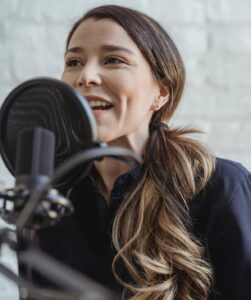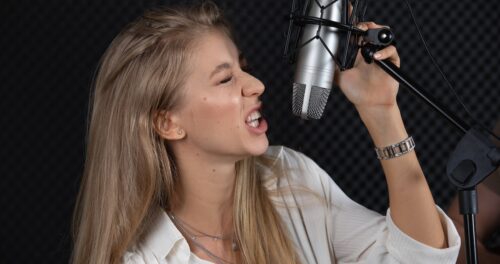Vocal fry is a creaky, crackling sound you’ve probably heard from singers, actors, and even reality TV stars like the Kardashians. While some people love it, others find it grating. But what exactly is this unique vocal quality? And why does it matter for voice overs, singing, or everyday speech?
At Voice123, the home of incredibly talented voice actors, we understand the value that distinctive voices and sound effects contribute to audio and video projects. So, in this article, we’ll break down what is vocal fry and explain how to use it in voice over projects.
What is vocal fry

Vocal fry is: a creaky, low-pitched quality of the human voice created when the vocal cords are relaxed and vibrate slowly. This results in a popping or rattling sound at the lowest part of your vocal range.
Think of the sound your voice makes when you wake up in the morning and groggily say “hello.” That gravelly quality? That’s voice fry in action. For example, a podcast host can narrate an excerpt from a thriller using a fry voice style to emphasize a chilling revelation in the plot.
Vocal fry meaning in everyday speech
The vocal fry meaning goes beyond sound—it’s often about style and perception. It’s sometimes called glottal fry in linguistics, since it’s produced at the glottis (the space between the vocal folds). In the media, many celebrities use it as a stylistic choice to sound relaxed, mysterious, or even authoritative. Here’s a complete breakdown:
- Expressive variation: Fry is typical in tonal languages like Vietnamese and Burmese. So, if it accentuates other languages, some believe it could add unique tones to American English speech through stylistic expression.
- Social connection: Some studies suggest that it is a social marker. It acts as a bonding tool within social groups, creating a sense of belonging and making people feel more socially acceptable.
Disadvantages of using vocal fry
Some people consider this technique unprofessional in formal environments because the tone lacked proper articulation. Consistently using it can also cause damage to the vocal cords. Medical Journals have released information that it can strain a person’s voice, causing discomfort or fatigue.
How does vocal fry work?
Normally, your vocal folds come together and vibrate smoothly when you speak. In glottal fry, the folds are loose and floppy, vibrating at a much slower rate. This creates that creaky, sizzling sound in the lowest register of your voice.
It’s not just a quirk—it’s a natural vocal register, just like chest voice, head voice, or falsetto.
Famous vocal fry voices
Several celebrities have popularized glottal fry:
- The Kardashians are arguably the most famous example.
- Zooey Deschanel often uses fry for quirky animated roles.
- Britney Spears‘ early singing career leaned heavily into fry for stylistic effect.
- Podcast hosts use this technique in investigative or narrative shows, where it creates a moody, intimate vibe.
How to use vocal fry in voice over projects
- Entertainment projects: In film, gaming, or animation, glottal fry adds grit, mystery, and intensity to characters.
- Podcasts and narration: A subtle voice fry can make narration feel intimate and suspenseful, drawing listeners closer to the story.
- Advertising and branding: This technique can make content authentic and memorable when a brand identity is edgy or bold.
- Professional settings: Too much fry in presentations, training, or meetings may come across as disinterested or low-energy.
- Overall balance: Use it intentionally for emphasis, mood, or character, and always keep audience perception in mind.
Final thoughts
So, what is a vocal fry? It’s a natural vocal register, sometimes controversial, sometimes powerful. But, when used well, it can enhance performances, add emotional weight, and create memorable characters. But like any technique, it works best when balanced and intentional.
So, if you’re ready to start casting voices for your next project, hire professional voice actors from Voice123 to enhance your storytelling. Post your project today!
FAQs
It usually indicates the speaker’s voice is at its lowest register. Sometimes it’s just a habit, other times it’s used for stylistic effect.
The vocal technique isn’t exclusive to Millennials but is more common because of social influence. It creates relatability and group identity.
Kim Kardashian is the most famous example, though Britney Spears, Zooey Deschanel, and Sarah Koenig also use it.
Not exclusively. While it became widely recognized in California speech patterns, especially among young women, it exists across languages and regions worldwide.
